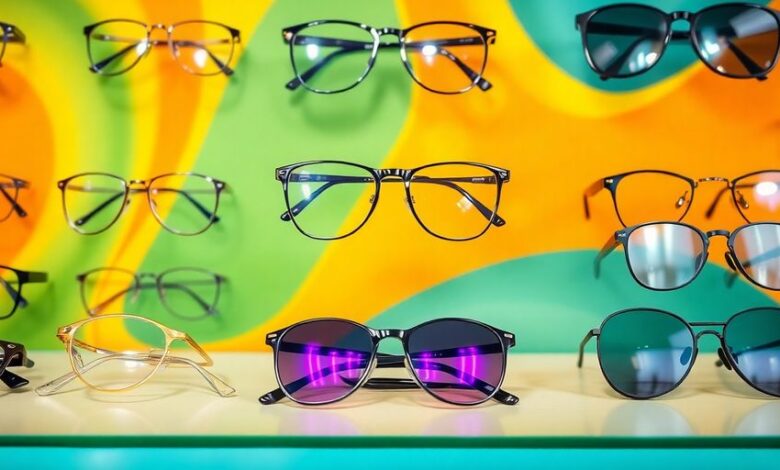
Are you passionate about eyewear and thinking about starting your own optical business? The optical market is booming, and with the right knowledge and strategies, you can carve out your own niche. From understanding market trends to creating a welcoming space for customers, this guide will help you navigate the steps to launch a successful optical practice. Let’s explore how you can turn your eye for eyewear into a thriving business today!
Key Takeaways
- Research current trends and understand your target audience.
- Create a solid business plan and ensure you meet legal requirements.
- Design a visually appealing and functional optical space.
- Build a strong brand identity that resonates with your community.
- Implement effective marketing strategies to attract and retain customers.
Understanding The Optical Market

Current Trends In Eyewear
Okay, so first things first, let’s talk about what’s hot right now in the eyewear world. It’s not just about seeing clearly anymore; it’s a whole fashion statement. Think bold frames, sustainable materials, and a real push for personalization. People want glasses that show off their style, not just fix their vision.
- Big, oversized frames are still trending, especially in retro styles.
- Sustainable materials like bamboo and recycled plastics are gaining popularity.
- Blue light glasses are a must-have, given how much time everyone spends staring at screens.
The eyewear market is changing fast. It’s not enough to just sell glasses; you need to sell an experience, a lifestyle. People are looking for something unique, something that reflects who they are.
Target Demographics For Optical Businesses
Who are you trying to sell to? That’s the big question. You can’t be everything to everyone, so figuring out your ideal customer is key. Are you going after the younger crowd, the older folks, or maybe a specific niche like athletes? Each group has different needs and wants. For example, younger customers might be more interested in trendy styles and online shopping, while older customers might value personalized service and high-quality lenses. Understanding these differences is crucial for tailoring your marketing strategies and product selection.
- Millennials and Gen Z: Fashion-conscious, tech-savvy, and value sustainability.
- Baby Boomers: Focus on comfort, quality, and vision correction for age-related issues.
- Athletes: Need durable, performance-oriented eyewear with UV protection.
Competitive Landscape Analysis
Alright, let’s be real – the optical business is crowded. You’ve got the big chains, the online retailers, and the local optometrists all fighting for the same customers. To stand out, you need to know what everyone else is doing. What are their strengths? What are their weaknesses? Where can you find a gap in the market? Maybe it’s offering super personalized service, focusing on a specific niche, or creating a really cool, unique brand. Whatever it is, you need to find your edge. It’s important to understand the competitive landscape before you even think about opening your doors.
| Competitor Type | Strengths | Weaknesses |
|---|---|---|
| Big Chains | Wide selection, established brand | Can feel impersonal, less flexible |
| Online Retailers | Convenience, lower prices | No in-person fitting, potential quality issues |
| Local Optometrists | Personalized service, trusted relationships | Limited selection, higher prices |
Essential Steps To Launch Your Optical Business
So, you’re ready to jump into the world of eyewear? Awesome! But before you start picking out frames, there are some key steps to take to make sure your business has a solid foundation. It’s more than just liking glasses; it’s about building a business that lasts.
Creating A Comprehensive Business Plan
A solid business plan is your roadmap to success. Think of it as the blueprint for your entire operation. It’s not just about getting funding (though it helps!), it’s about understanding your market, your costs, and your potential profits. I know, it sounds boring, but trust me, it’s worth it. You need to know your KPIs and your monthly expenses: employee salaries, health insurance, office supplies, etc. To make your optical business profitable, it is important to know your target market and who is most likely to enter your store. Taking this approach will help you make better decisions in the future.
- Market analysis: Who are your customers?
- Financial projections: Can you make money?
- Operational plan: How will you run things?
A well-thought-out business plan can be the difference between a thriving business and one that struggles to stay afloat. It forces you to think critically about every aspect of your operation, from marketing to finances.
Legal Requirements And Licensing
Okay, let’s talk about the not-so-fun stuff: legalities. You can’t just open up shop without the right paperwork. You’ll need to get all your ducks in a row when it comes to licenses and permits. Contact the U.S. Small Business Administration (1-800-827-5722) for a local SBA office. Obtain a business license and a DBA (Doing Business As). Obtain retail tax, Federal and State ID numbers and obtain business insurance. Contact an attorney to assist with: determining and establishing the type of business and in lease negotiations.
- Business license
- Retail tax ID
- Federal and State ID numbers
Choosing The Right Location
Location, location, location! It’s an old saying, but it’s true. Where you set up shop can make or break your business. You want to be somewhere with good foot traffic, easy access, and a demographic that matches your target market. The U.S. Census Bureau allows you to search by ZIP code, city, county and/or state to find a specific area’s income levels, ethnicities, ages and other social characteristics.
- Foot traffic
- Accessibility
- Demographics
Designing An Inviting Optical Space

Importance Of Aesthetic Appeal
Let’s be real, nobody wants to shop in a place that looks like a drab doctor’s office. The aesthetic appeal of your optical space is super important. It’s the first thing customers notice, and it sets the tone for their entire experience. Think about it: a well-designed space communicates professionalism, style, and attention to detail. It tells your customers that you care about their experience and that you’re invested in providing them with the best possible service. It’s not just about looking pretty; it’s about creating an environment where people feel comfortable, confident, and excited to choose their new eyewear. Remember, over 80% of the information our brains process is visual, so make it count!
Functional Layout For Customer Experience
Okay, so your shop looks amazing, but can people actually move around? A functional layout is just as important as aesthetics. You want to create a space that’s easy to navigate, encourages browsing, and makes the entire process of selecting and purchasing eyewear as smooth as possible. Consider the flow of traffic, the placement of displays, and the accessibility of different areas. Are your frames displayed in a way that’s easy to see and reach? Is there enough space for customers to try on glasses comfortably? Is the checkout area conveniently located? These are all questions to ask yourself when designing your layout. Don’t forget to consider space planning to maximize efficiency and customer flow.
Here are some things to keep in mind:
- Clear Sightlines: Make sure customers can easily see different areas of the store.
- Comfortable Seating: Provide comfortable seating in the waiting area and near the dispensing tables.
- Accessible Design: Ensure your space is accessible to customers with disabilities.
A well-designed layout not only enhances the customer experience but also improves the efficiency of your staff. It’s a win-win!
Incorporating Technology In Design
In today’s world, technology is everywhere, and your optical business should be no exception. Incorporating technology into your design can not only enhance the customer experience but also streamline your operations. Think about digital displays showcasing the latest trends, virtual try-on apps that allow customers to see how they look in different frames, and electronic health record systems that make managing patient information easier. Technology can also be used to create a more personalized experience for your customers, such as using data analytics to recommend frames based on their preferences.
Here are some ideas:
- Virtual Try-On Stations: Allow customers to virtually try on frames using tablets or interactive mirrors.
- Digital Displays: Use digital displays to showcase new arrivals, promotions, and educational content about eye health.
- Online Integration: Make sure your physical space is integrated with your online presence, such as allowing customers to book appointments online or browse your inventory before visiting the store.
Building A Strong Brand Identity
Crafting Your Brand Story
Your brand story is more than just a tagline; it’s the narrative that connects with your customers on an emotional level. It communicates your values, your mission, and what makes you different. Think about what inspired you to start your optical business. Was it a personal struggle with finding the right eyewear? A desire to provide better eye care in your community? Whatever it is, make it authentic and relatable. Share this story on your website, in your marketing materials, and with your staff so they can share it with customers. It’s about creating a connection that goes beyond just selling glasses. Consider these points when crafting your story:
- What problem are you solving?
- What are your core values?
- What is your vision for the future?
Visual Branding Elements
Visuals are key. Your logo, color palette, typography, and even the design of your store all contribute to your brand identity. It’s important to maintain consistency across all platforms, from your website and social media to your business cards and in-store signage. A well-designed logo is memorable and instantly recognizable. Your color palette should evoke the emotions you want your brand to represent. For example, blues and greens can convey trust and reliability, while brighter colors can signal energy and innovation. If you need help, full-service design firms can help you create a cohesive brand image.
Engaging With Your Community
Being an active member of your community is a great way to build brand awareness and loyalty. Sponsor local events, participate in health fairs, or partner with other local businesses. Offer free vision screenings at schools or senior centers. Not only does this help people in need, but it also positions your business as a caring and responsible member of the community. Word-of-mouth marketing is incredibly powerful, and people are more likely to support businesses that give back. Consider these ideas:
- Host a trunk show featuring local eyewear designers.
- Partner with a local charity to donate a portion of your sales.
- Offer discounts to teachers, first responders, or other community groups.
Remember, building a strong brand identity takes time and effort. It’s not just about creating a logo and writing a mission statement. It’s about consistently delivering on your brand promise and creating a positive experience for your customers. When you do that, you’ll build a loyal following that will help your business thrive. Think about how you can use marketing strategies to help you stand out from the competition.
Effective Marketing Strategies For Optical Businesses
Utilizing Social Media Platforms
Okay, so you’ve got an optical business. Now what? Time to get the word out! Social media is a huge deal these days. It’s not just for sharing vacation pics; it’s a powerful tool to connect with potential customers. Think about running targeted ads on platforms like Facebook and Instagram. You can really narrow down who sees your ads based on things like age, location, and interests. Post engaging content – maybe some behind-the-scenes looks at your shop, tips on eye care, or even just fun polls about frame styles. Don’t forget TikTok, either! Short, snappy videos showcasing your coolest eyewear can go viral.
Local Advertising Techniques
Don’t underestimate the power of good old-fashioned local advertising. Think about sponsoring a local sports team or event. It gets your name out there and shows you’re invested in the community.
- Flyers and brochures in local businesses
- Partnering with nearby doctors’ offices
- Ads in the local newspaper or community newsletter
Word-of-mouth is still king. Happy customers are your best advertisement. Encourage them to leave reviews online and offer referral discounts. A little incentive can go a long way in building a loyal customer base.
Building An Online Presence
Having a website is non-negotiable. It’s your digital storefront, open 24/7. Make sure it’s easy to navigate, mobile-friendly, and showcases your products and services. Invest in good SEO (Search Engine Optimization) so people can actually find you when they search for “eye doctor near me” or “best glasses in town.” Consider starting a blog where you can share helpful articles about eye health, the latest eyewear trends, and tips for choosing the right frames. This not only boosts your SEO but also establishes you as an authority in the field.
Here’s a simple table to track your online performance:
| Metric | Target | Actual |
|---|---|---|
| Website Visits | 500/mo | 450 |
| Social Followers | 1000 | 800 |
| Online Bookings | 50/mo | 40 |
Maximizing Profitability In Your Practice
Understanding Your Cost Structure
Okay, so you’ve got your optical business up and running. Now comes the part where you actually, you know, make money. First things first: you gotta know where your money is going. I mean, really know. It’s not just about rent and frames; it’s about every single expense, big or small.
- Rent/Mortgage
- Utilities
- Salaries
- Inventory
- Marketing
Understanding your cost structure is the bedrock of profitability. Without a clear picture of your expenses, you’re basically flying blind. Track everything meticulously, categorize your spending, and regularly review your financials to identify areas where you can cut costs or improve efficiency.
Diversifying Product Offerings
Don’t just sell glasses. Seriously. Think about all the other things people who wear glasses might need or want. Contact lenses, obviously. But what about sunglasses? Or sports eyewear? Or even things like lens cleaning kits and cool cases? The more stuff you sell, the more chances you have to make a sale.
Here’s a quick table:
| Product Category | Average Profit Margin | Target Customer |
|---|---|---|
| Standard Frames | 40% | General Public |
| Premium Frames | 60% | Style Conscious |
| Contact Lenses | 30% | Active Lifestyles |
Enhancing Customer Experience
People will pay more for a good experience. It’s just a fact. So, make sure your customers are happy. Be friendly, be helpful, and go the extra mile. Offer free adjustments, send birthday cards, and remember their names. It’s the little things that make a big difference. I know this sounds obvious, but you’d be surprised how many places just don’t get it. Happy customers are repeat customers, and repeat customers are the key to long-term profitability.
Here are some ways to improve customer experience:
- Offer personalized styling consultations.
- Provide a comfortable and inviting waiting area.
- Implement a loyalty program to reward repeat business.
Learning From Industry Experts
Starting an optical business can feel like navigating a maze, but you don’t have to do it alone. One of the smartest things you can do is tap into the knowledge and experience of those who’ve already walked the path. It’s about more than just reading articles; it’s about actively engaging with the optical community.
Networking Opportunities
Networking is huge. Seriously. It’s not just about collecting business cards; it’s about building relationships. Think of it as planting seeds. You never know which connection might blossom into a partnership, a mentorship, or just a friendly ear when you’re having a rough day. Look for local optometry associations or even online forums where you can connect with other professionals. Don’t be afraid to reach out and ask questions. Most people are happy to share their experiences, both good and bad. You can learn a lot from their successes and, maybe even more, from their mistakes. Consider joining a local business group; you might find unexpected allies and referral sources there. Remember to actively listen and offer your own insights too. Networking is a two-way street.
Attending Trade Shows
Trade shows are like a candy store for optical business owners. They’re a fantastic way to see the latest eyewear trends, meet suppliers, and attend workshops. Plus, they’re a concentrated dose of networking. You’ll be surrounded by people who are passionate about the industry, and you can learn a ton just by walking around and talking to exhibitors. Check out Vision Expo or similar events. These shows often have educational sessions on everything from practice management to the newest lens technology. It’s also a great way to scope out the competition and see what other businesses are doing. Don’t forget to collect brochures and business cards, and follow up with the people you meet after the show. Trade shows can be an investment, but the knowledge and connections you gain can be invaluable. You might even find inspiration for visual branding elements.
Seeking Mentorship
Having a mentor can be a game-changer. A mentor is someone who’s been there, done that, and is willing to share their wisdom with you. They can provide guidance, support, and a reality check when you need it. Finding a mentor might seem daunting, but it’s worth the effort. Start by reaching out to people you admire in the industry. Ask if they’d be willing to meet for coffee or a quick phone call. Be clear about what you’re looking for in a mentor and what you hope to gain from the relationship. A good mentor can help you avoid common pitfalls, make better decisions, and stay motivated when things get tough. They can also provide honest feedback and help you see your business from a different perspective. Don’t be afraid to ask for help; most successful people have had mentors along the way. If you want to launch an online course, a mentor can help you with that too.
Learning from industry experts isn’t just about gaining knowledge; it’s about building relationships and creating a support system. It’s about finding people who can inspire you, challenge you, and help you grow your business. It’s an ongoing process, but it’s one that can make all the difference in your success.
Wrapping It Up: Your Optical Business Journey
Starting your own optical business can feel a bit overwhelming, but it’s definitely doable. With the right planning and a clear vision, you can carve out your niche in this competitive market. Remember, it’s all about knowing your customers, offering quality products, and creating a welcoming space. Don’t forget to keep learning and adapting as trends change. If you stick to these basics and stay passionate about what you do, you’ll be on your way to building a successful practice. So, are you ready to take the leap? Your journey into the world of eyewear awaits!
Frequently Asked Questions
What do I need to start my own optical business?
To start your optical business, you need a solid business plan, the right licenses, a good location, and a budget for supplies and equipment.
How can I make my optical store stand out?
You can make your store unique by offering high-quality products, creating a welcoming atmosphere, and using effective marketing strategies.
Who are my main customers in the optical market?
Your main customers will likely be people who need glasses or contact lenses, including kids, adults, and seniors.
What are some common mistakes to avoid when starting an optical business?
Common mistakes include not researching your market, underestimating costs, and failing to create a strong brand identity.
How can I keep my customers coming back?
To keep customers returning, offer excellent service, create loyalty programs, and engage with your community through events and promotions.
What trends should I be aware of in the eyewear industry?
Stay updated on trends like eco-friendly materials, stylish frames, and technology like virtual try-ons to attract more customers.



